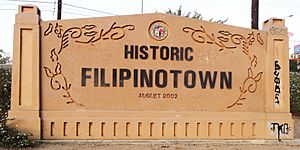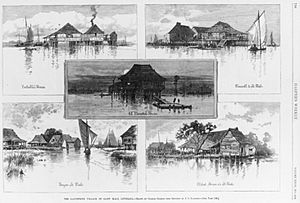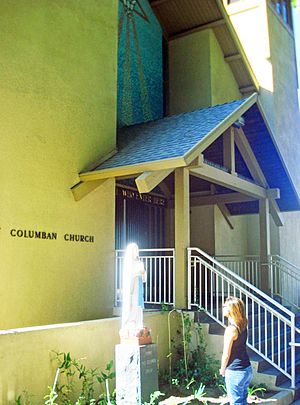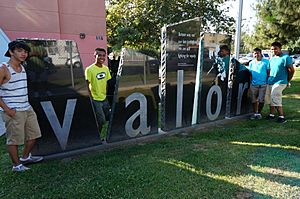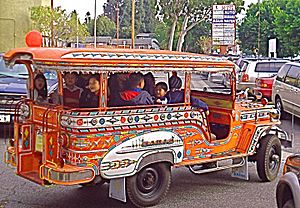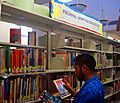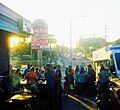Historic Filipinotown, Los Angeles facts for kids
Quick facts for kids
Historic Filipinotown
|
|
|---|---|
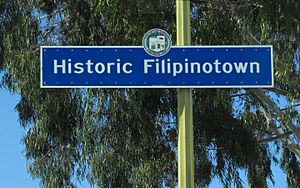
Historic Filipinotown signage located at
Beverly Boulevard and Belmont Avenue |
|
| Nickname(s):
HiFi
|
|
| Country | |
| State | |
| County | |
| Time zone | Pacific |
| Zip Code |
90026
|
| Area code(s) | 323 |
Historic Filipinotown (also called HiFi) is a neighborhood in Los Angeles, California. It is one of six neighborhoods in the city that celebrate Asian Pacific Islander cultures. Other similar areas include Chinatown and Koreatown.
Contents
A Look Back: Historic Filipinotown's Story
Historic Filipinotown is the first place outside the Philippines to be officially named by a city to honor Filipinos. This area was created to keep the history of the neighborhood alive. It also helps local residents and businesses grow and thrive.
Filipino Americans are the largest group of Asian Americans in California. They also have one of the oldest Asian American communities in the United States. Early Filipino settlements were in Louisiana, like St. Malo, founded in 1763. Filipino sailors and workers lived there. They were known for fishing and drying shrimp. These early settlements were later destroyed by bad weather.
Even though Filipinos live in many other parts of Los Angeles, this area was named "Historic Filipinotown." This is because it was one of the first places Filipinos settled in the early 1900s. It became home to important Filipino churches, organizations, and housing. Many Filipino American families started buying homes and opening businesses here in the 1940s. Before that, they lived in downtown areas like Little Tokyo.
In the 1920s, a lively community called Little Manila grew in downtown Los Angeles. Many Filipinos came to Los Angeles to study or find work. This community had restaurants, barbershops, and social clubs. It was a central place for Filipinos to meet, socialize, and find jobs.
Boxing was very popular among Filipinos in California. It brought people together, no matter their background. Some historians also believe that Filipinos in Los Angeles were the first to wear Zoot Suits.
Today, Historic Filipinotown is home to many different cultures. While it still has a large Filipino population, there are also many Mexican and Central American residents. Still, it has one of the highest numbers of Filipino Americans in Southern California. It remains a cultural center for Filipinos throughout Los Angeles.
On October 31, 2011, Historic Filipinotown received a special honor. It was named a Preserve America Community. This means it gets strong support from the U.S. government to protect its cultural heritage. This honor helps share the story of Filipino Americans in Los Angeles.
Historic Filipinotown Community Life
The Historic Filipinotown Neighborhood Council (HIFINC) works to improve the area. Many Filipino organizations are located here. These include groups that help workers, families, and young people. You can also find many Filipino restaurants, churches, and health clinics.
Three big events happen every year in Historic Filipinotown:
- The Annual Historic Filipinotown Festival and 5k Run/Walk. This event celebrates the district's official naming. It features music, dances, food, and health information. It happens every first Saturday of August.
- The Philippine Independence Day Parade and Festival. This event celebrates the Philippines' national day. It is held every first Saturday of June.
- The Annual Christmas Lantern Parade and Festival. After Thanksgiving, the streets are decorated with beautiful Philippine Christmas lanterns called Parol. This kicks off the Christmas season, which lasts until January.
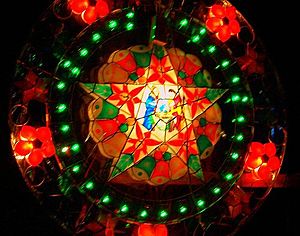
Important Cultural Landmarks
Filipino Christian Church and St. Columban Filipino Catholic Church
The Filipino Christian Church was named a Los Angeles Historic-Cultural Monument in 1998. It is the only historic monument in Los Angeles with Filipino roots. This church is known for its unique German Gothic Revival and Craftsman style. It was one of the earliest Christian churches for Filipino Americans. Many important community groups started here.
The St. Columban Filipino Church has real church bells from Antipolo City, Philippines. It sits on Crown Hill, one of the five hills around old Los Angeles.
Gintong Kasaysayan, Gintong Pamana Mural
Before the area became Historic Filipinotown, a huge mural was created in 1995. It is called Gintong Kasaysayan, Gintong Pamana, which means "Filipino Americans: A Glorious History, A Golden Legacy." This mural is the largest Filipino American mural in the country. It shows 5,000 years of Filipino and Filipino American history. The mural has been featured in many art shows and exhibitions. It was painted by Eliseo Art Silva when he was 22 years old.
Unidad Park
The mural faces Unidad Park, which used to be a community garden. The park's design was created by Filipino community leaders. It includes features inspired by the Rice Terraces of the Philippine Cordilleras. This is a UNESCO World Heritage Site in the Philippines. The park is a popular spot for families. It has play areas, a community garden, and barbecue spots.
Hi-Fi Signs, Street Medallions, and Crosswalks
In 2007, signs were put up along the US 101 Freeway to direct people to Historic Filipinotown. The crosswalks in Filipinotown have special designs. They look like traditional Filipino basket-weaving patterns. These designs were created by artist Edwin Frederizo. He also designed the street banners for Hi-Fi.
Filipino American WWII Veterans Memorial
In 2006, a special monument was unveiled in Lake Street Park. It honors the 250,000 Filipino and 7,000 Filipino American soldiers who fought for the United States in World War II. This monument tells the story of these veterans. It also shares their fight for equality. The artist Cheri Gaulke designed it.
Future Plans for the Area
There are exciting plans for Historic Filipinotown's future. These include:
- A permanent building for the Filipino American Library.
- Naming a community center after Larry Itliong, a Filipino labor leader.
- Creating a community garden named after Uncle Roy Morales and Philip Vera Cruz.
- Placing statues of Philippine national hero Jose Rizal and writer Carlos Bulosan at Unidad Park.
- Building an eastern gateway to the district along Temple Street.
- Adding more public art that shows Filipino culture.
- Developing a shopping mall with a design inspired by Filipino history.
- Creating an "American Filipino Museum and Gallery of Art."
Gallery
-
At night, the area comes alive with Karaoke Nights at Luzon Plaza's Kapistahan Grill where anyone can be the star. Alongside a series of vibrant events, Sunday Jump is the only Filipino-founded open mic series held every 1st Sundays, providing a safe space for those to express free speech and uplift communities.
Who Lives Here: Demographics
In 2010, about 66% of the people living in Historic Filipinotown were Latino. About 25% were Asian, with Filipinos being the largest group among them. About 64% of the Asian residents were Filipino. White and Black residents each made up about 4% of the neighborhood.
Learning and Education
Local Schools
The following schools are located within Historic Filipinotown:
- Rosemont Elementary School, 421 Rosemont Avenue
- Alliance Ted K. Tajima High School, 1552 Rockwood Street
Samahang Pilipino Advancing Community Empowerment (SPACE)
SPACE is a project started in 2000 by students at UCLA. It helps high school and community college students in Los Angeles. SPACE provides tutoring, advice, and workshops. It helps students succeed in school and plan for college. In 2015, SPACE held an event called Philippine Youth Empowerment Day. This event had workshops about Filipino-American history and identity.
Images for kids
-
Halo-halo is a popular Filipino dessert available in most restaurants within the district.



